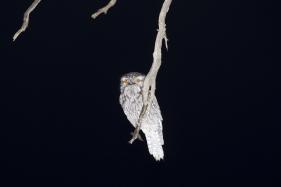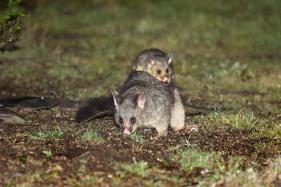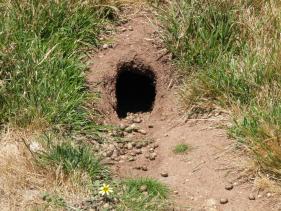A range of teacher professional learning programs will be developed to accompany the Biodiversity of the Western Volcanic Plains online outreach...
Point 6

Tawny Frogmouth
(Podargus strigoides)
A bird that may be seen camouflaged on a branch during the day or night is the Tawny Frogmouth. Often mistaken for an owl, the Tawny Frogmouth is found throughout Australia in many habitats. Tawny Frogmouths are nocturnal so are best spotted at Mt Rothwell during a night walk. Their silver-grey plumage and cryptic poses often make them extremely hard to see amongst the branches of the eucalypts in the grassy woodland where they roost. The conservation status of this bird is secure.
Introduced weeds
A major threat to biodiversity at Mt Rothwell is weed infestation. Ongoing eradication of highly invasive weeds is carried out by staff and volunteers. One method used to manage weed infestation at Mt Rothwell is to establish native species that have the ability to outcompete weed species. A major threat to the area is Serrated Tussock (Nassella trichotoma). This is a perennial, highly invasive grass which outcompetes many native grass species. Another highly invasive common weed of the area is the yellow flowered Cape Weed (Arctotheca calendula).
Hedge Wattle
(Acacia paradoxa)
This Acacia species provides a valuable resource for birds due to its dense growth and many sharp spines. It makes an ideal nesting site for small insectivorous birds such as the Superb Fairy-wren and the White-browed Scrub Wren. While native to the Victorian Volcanic Plain in Victoria, it has become an environmental weed in other parts of Victoria and in other states.

Common Brushtail Possum
(Trichosurus vulpecula)
Brushtail Possums are often seen wandering around Mt Rothwell at night, often carrying young. These nocturnal marsupials are very adapted to living in suburban areas. They are the most widespread of all Australian marsupials and are considered a pest species, since being inroduced into New Zealand.

European Rabbit
(Oryctolagus cuniculus)
Rabbits continue to be monitored and controlled within Mt Rothwell. The DEPI has listed the European Rabbit as an established pest animal in Victoria. They now inhabit most areas of Victoria except alpine areas and closed forest environments. It was not possible to eradicate all of the rabbits at Mt Rothwell before the feral proof fence was erected, so ongoing management of the rabbit population is required. Rabbits selectively feed on native plant seedlings, impacting on revegetation and recruitment of these species. They are often in direct competition with native herbivores for food and habitat. Their burrows prevent revegetation and cause excessive soil erosion. Rabbit numbers are controlled on the property by shooting. The use of bait is not possible due to the risk to native mammals. In 1859, approximately seven rabbits were released at Barwon Park near Geelong. By 1875, the rabbit was well established in the western district of Victoria, South Australia and New South Wales. By the 1920s, rabbits had colonised most of the southern half of Australia.
Map Legend
-
1Entry point on map
-
AProfile flora, fauna and features



